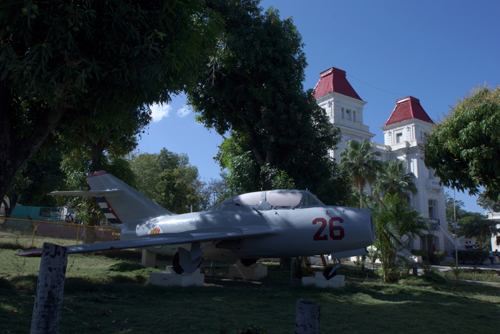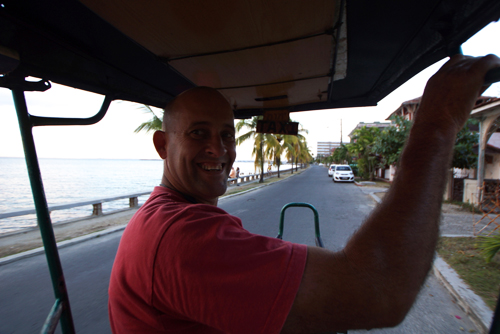It’s 270km from Camagüey to Santiago de Cuba – it seemed a lot longer.
To start with the bus was late and then the air conditioning broke down.
The ingenuity of the Cubans came to the fore yet again. Not only did they carry spare parts in the bus but the driver and co driver were able to carry out the repairs.
As it turned out we were only 55 late minutes in leaving.
The vast plantations that we had seen in the western regions had given way to smaller market gardens interspersed between cattle, sheep and horse grazing.
The land seemed to be dryer, the properties poorer and the roads weren’t as good.
At some points we were reduced to a crawl as the driver negotiated potholes of ‘Uzbek proportions’
Then the land opened up again and we were back to cane fields and rice paddies, all under irrigation – probably fed by the Rio Cauto.
At the end of the long journey, the seats felt harder and the air-con was failing again.
We were picked up at the bus depot by a Mercedes Benz – it had seen far better days.
Our Casa was outside of the old town again, which was rather annoying. The family were pleasant and the room was very quiet.
A good nights sleep at last.
The area is the formally posh part of Santiago de Cuba, that was abandoned after Castro came to power. Just near our Casa was Avenue Manduley, a wide, tree lined boulevard with many magnificent old homes on large landscaped blocks.
There was a combination of styles ranging from Italianate to Grand Spanish Colonial.
One of these beautiful old mansions, Palacio de Pioneros, is now a development centre for gifted children.
As part of it their playground equipment there is an old MiG fighter.
Just off the main street the homes were more modest but still large and on freestanding blocks.
This area was having somewhat of a renaissance as many of the houses were being renovated.
The next day we made the long walk into the historical centre and just slowly walked around. The temperature was now in the thirties and we were looking for shade at every turn.
Plaza Dolores is a small square just outside of the old city area. It was our first cool drink spot for the day.
There were a few more.
There seemed to be a strange system of service, with water, coffee and ice cream all coming from different vendors, but brought to us by one person.
This would have something to do with the very erratic state of supply in Cuba.
I suspect our waitress made a commission on each sale.
Bacardi Rum was established Santiago de Cuba in 1862, where they made their very distinctive ‘white rum’. Here there is a very grand museum, in the original distillery, dedicated to the Bacardí family.
Facundo Bacadí Masó, the first Bacardí, was born in Sitges, near Barcelona in 1813 and died in Santiago de Cuba in 1886. Within those 73 years he laid the foundations for one of the world’s great rum brands and the world’s largest privately owned spirit companies.
Santiago de Cuba have their own version of Carnival and they have a small museum to celebrate this festival.
It’s a very humble exhibition with costumes of past winners, photos and other memorabilia.
There is a resident graphic artist whose main task is to design posters for the event.
These were all done ‘Old School’ – by hand, with paint and brush, on an easel.
There was not a computer in sight.
Parque Céspedes is the focal point of the old city and it’s surrounded by elegant buildings. Apart, that is, from the rather plain Banco Nacional de Cuba.
The Catedral de Nuestra Señora de la Asunción, sitting at one end of the park, is undergoing massive restorations so the exterior view was all that was available. We did however get a sneak preview of the interior works – this was of course for a small fee.
Opposite the Catedral are the municipal offices, Edificio del Antiguo Ayuntamiento.
Also on the square is the house that was built for for the first governor, Casa de Diego Velázquez. This is said to be the oldest house in Cuba.
We meandered down to the port area via the Tivoli, or old French quarter. It was near 5pm and closing time for the Museo de la Lucha Clandestina. This is a former police station that was attacked on November 30, 1956 as a diversion for the landing of Fidel and his group on the yacht Granma.
The port is a sad reflection of what must have been colonial times.
There was one small cruise ship and not much more.
We have seen abandoned tram tracks in Havana, Camagüey and now in Santiago de Cuba. What narrow minded forefathers would replace electric trams with diesel buses? Cuba is not alone as we have witnessed this in France and of course in Australia.
Santiago de Cuba is a city of touts.
For every one that approaches you, and there are many, and there are at least a dozen more waiting in the shadows planning their move. It’s a pity their enthusiasm doesn’t rub off onto the restaurant staff.
Service here is the worst we have seen and most staff just don’t seem to want to do their job. It’s no wonder they are jaded as they continually have to apologise for not having the essentials.
We returned to the Parque Céspedes in the late afternoon. There was a small band playing a variety of music and directed by a clarinet player who seemed to have little control over the group. After the music finished we went to the rooftop bar of the Hotel Casa Granda, that’s adjacent to the square. We got there early enough to get a table on the edge of the balcony, overlooking the park.
This was the place to be, as it was facing west and we enjoyed a cool drink as the cruise boat sailed into the sunset.
This is the hotel and bar that features in Graham Greene’s ‘Our Man in Havana’.
There is an extra charge of 2 CUCs but it’s worth it.
Our last day in Santiago de Cuba started with our Casa Particular owner telling us we were due to leave that morning, as he had our room booked for that night. This was an issue as we were booked to fly out the next morning and now found ourselves with nowhere to stay.
It took time and effort to find, and then book into a hotel. We were helped by the owners who were ever apologetic. It wasn’t their mistake, but that of the booking agent, who had failed us yet again.
We didn’t want to move to another Casa as we needed to leave very early the next day, so we booked into the Hotel las Américas. Here we got a bargain basement deal.
It’s no wonder as it was a very shabby, 1960s, government run hotel and just around the corner from here we had been staying.
Having paid for a cheap bed we walked down the road to the much grander Meliá Santiago de Cuba to use the last of our internet card and enjoy their more luxurious surroundings.
Then there was an earthquake.
It wasn’t very big and didn’t last long but it did prove, once and for all, that you should expect the unexpected in Cuba.















